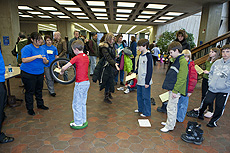Kids of all ages welcome at Fermilab's Family Open House on Sunday, Feb. 10
 |
Children at last year's Fermilab Open House participate in one of the interactive exhibits put on by a local high-school student group. Photo: Cindy Arnold
|
On Sunday, Feb. 10, Fermilab's Wilson Hall will come alive with the sounds of science.
The U.S. Department of Energy's Fermi National Accelerator Laboratory will host its annual Family Open House on Feb. 10 from 1 to 5 p.m. The open house offers activities for the whole family, from hands-on science exhibits to tours of some of the lab's attractions.
Highlights include a performance by the always popular Jerry Zimmerman as "Mr. Freeze," demonstrating the (very) cool effects of liquid nitrogen. Kids can also check out Mike Cooke's show "FUNdamental Physics," while parents and older kids will enjoy Herman White's historical talk "Great Science on the Prairie."
About a dozen scientists will be ready to answer your questions on the 15th floor of Wilson Hall, and while you're there, you can check out the spectacular view of Fermilab's site and the surrounding area. In the atrium, families can enjoy a "physics carnival," including interactive exhibits by students from five local schools: Naperville Central and Naperville North high schools, Payson High School, and Northside College Prep and Christo Rey Jesuit high schools in Chicago.
Tours of the Linear Accelerator and Main Control Room will be given throughout the day, and tours of the SeaQuest experiment will leave Wilson Hall at 1:30, 2:30 and 3:30 p.m. Register at ed.fnal.gov/ffse_new/openhouse. There are a limited number of seats available, and standbys will be accepted.
No registration is required to attend the Family Open House. More than 2,000 people are expected to attend.
"We want to get kids doing activities that get them excited about science," said Spencer Pasero, an education program leader at Fermilab. "We want them to come in, have fun and think about science as something they could do."
The Family Open House is made possible by an anonymous donor to the nonprofit organization Fermilab Friends for Science Education.
Read more
|